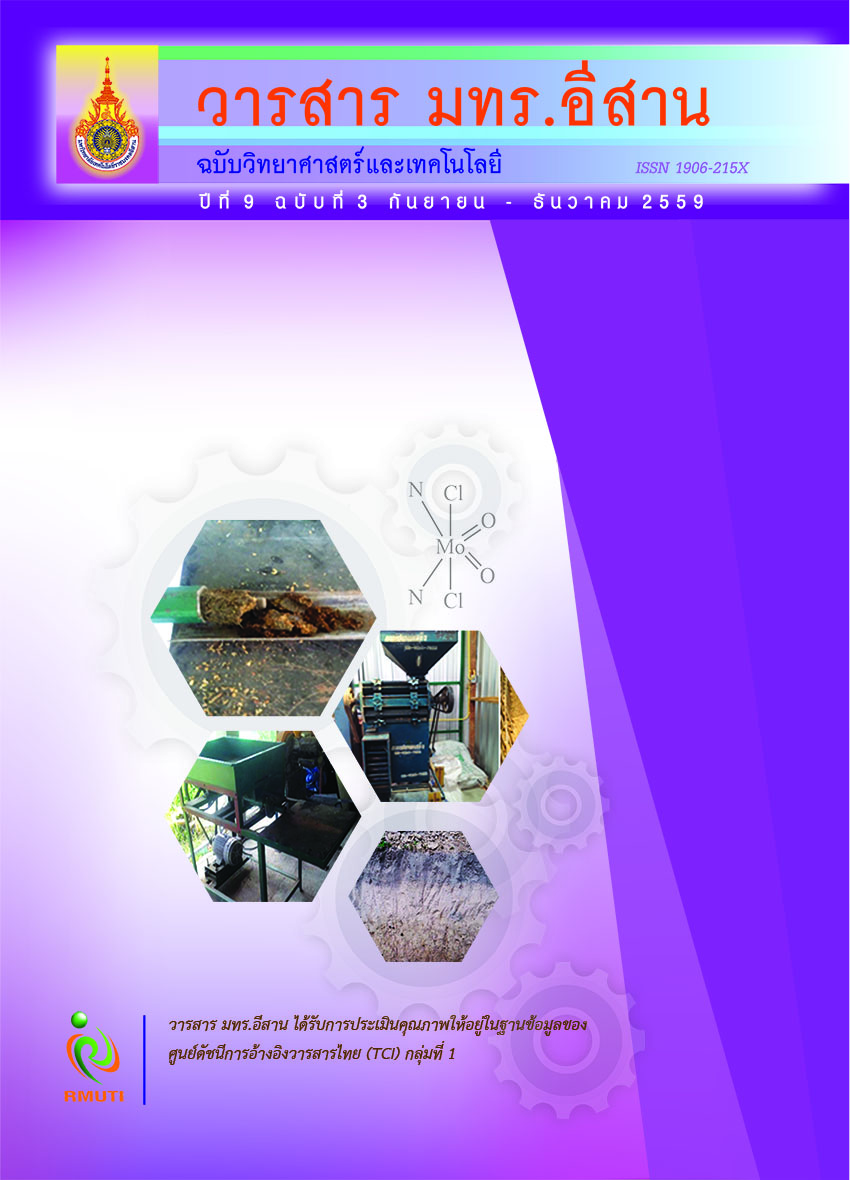A Study of the Properties of Bagasse Ash for the Possibility in Making Light Weight Block
Main Article Content
Abstract
This research aimed to investigate the properties of bagasse ash in producing light-weight
concrete block. In this work, the bagasse ash from the sugar industries was used as
the raw material in the production. It was found that bagasse ash is the pozzolan
because it is mixed with many silica and alumina which strengthen the concrete.
The researchers designed 13 formula for the mixing ratio among dried bagasse,
bagasse ash, and Portland cement. The mechanical properties were then tested.
As the experimental results, the compression strength had the significant relationship
with three compounds at the level of P < 0.05. From the analysis of each formula,
a mixture of 2 percent dried bagasse, 65 percent bagasse ash, and 33 percent Portland
cement gave the optimal compression strength at 1.4 MPa while the general light
concrete block had compression strength of 0.6 MPa with around 30 percent different.
However, the formula can be further developed in the future.
Article Details
References
[2] Office of Agricultural Economics. (2010). Agricultural statistics of Thailand. Access (11 August 2014). Available (https://www.oae.go.th/main.php?filename= journal_all)
[3] Surin, P. and Buasri, K. (2012). The Study Feasibility in Production Roof tile from Bagasse Fiber Mixed Maize Husk Fiber. In: Lun KC, Degoulet P, Piemme TE, Rienhoff O, editors. In Proceeding of IE Network Conference 2012; Phetchaburi, Thailand. pp. 1527-1535
[4] Chusilp, N., Jaturapitakkul, C. and Kiattikomol, K. (2009(a)). Effects of LOI of Round Bagasse ash on the Compressive Strength and Sulfate Resistance of Mortars. Construction and Building Materials. Vol. 23. No. 12. pp. 3523-3531
[5] Chusilp, N., Jaturapitakkul, C. and Kiattikomol, K. (2009(b)). Utilization of Bagasse
ash as a Pozzolanic Material in Concrete. Construction and Building Materials.
Vol. 23. No. 11. pp. 3352-3358
[6] Cordeiro, G.C., Toledo Filho, R.D., Tavares, L.M. and Fairbairn, E.M.R. (2008). Pozzolanicactivity and Filler Effect of Sugar Cane Bagasse ash in Portland Cement and Lime Mortars. Cement and Concrete Composites. Vol. 30. No. 5. pp. 410-418
[7] Martirena Hernandez, J.F., Middendrof, B., Gehrke, M. and Budelmann, H. (1998). Use of Waste of Sugar Industry as Pozzolana Inlime-Pozzolana Binders: Study of the Reaction. Cement and Concrete Research. Vol. 28. No. 11. pp. 1525-1536
[8] Paya, J., Monzo, J., Borrachero, M.V., Diaz-Pinzon, L. and Ordonez, L.M. (2002). Sugar-Cane Bagasse Ash (SCBA): Studies on its Properties for Reusing in Concrete Production. Journal of Chemical Technology and Biotechnology. Vol. 77. No. 3. pp. 321-325
[9] Singh, N.B., Singh, V.D. and Rai, S. (2000). Hydration of Bagasse Ash-Blended Portland Cement. Cement and Concrete Research. Vol. 30. No. 9. pp. 1485-1488
[10] Villar-Cocina, E., Frias, M. and Valencia-Morales, E. (2008). Sugar Cane Wastes as Pozzolanic Materials: Application of Mathematical Model. ACI Materials Journal. Vol. 105. No. 3. pp. 258-264
[11] Sabsaree, J. (2012). Minitab 14 manual. Access (17 February 2015). Available
(https://www.training/minitab14.html)
[12] Haaland, P.D. (1989). Experimental Design in Biotechnology. Marcel Dekker, Inc., New York. USA
[13] Ozer, B. and Ozkul, M.H. (2004). The Influence of Initial Water Curing on the Strength Development of Ordinary Portland and Pozzolanic Cement Concretes. Cement and Concrete Research. Vol. 34. No. 1. pp. 13-18

